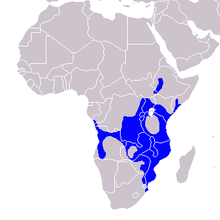Crowned hornbill
| Crowned hornbill | |
|---|---|
 | |
| Adult male at Ndumo Game Reserve in KwaZulu Natal, South Africa | |
| Scientific classification | |
| Kingdom: | Animalia |
| Phylum: | Chordata |
| Class: | Aves |
| Order: | Bucerotiformes |
| Family: | Bucerotidae |
| Subfamily: | Bucerotinae |
| Genus: | Lophoceros |
| Species: | L. alboterminatus |
| Binomial name | |
| Lophoceros alboterminatus (Büttikofer, 1889) | |
 | |
| approximate distribution (range extends to the southern Cape) | |
| Synonyms | |
|
Lophoceros alboterminatus | |
The crowned hornbill (Lophoceros alboterminatus) is an African hornbill.
Description

It is a medium-sized bird, 50–54 centimetres (20–21 in) in length, and is characterized by its white belly and black back and wings. The tips of the long tail feathers are white. The eyes are yellow; the beak is red and presents a stocky casque on the upper mandible. In females, the casque is smaller. The crowned hornbill can be distinguished from the similar Bradfield's hornbill by its shorter beak.
Habitat
The crowned hornbill is a common resident of the coastal and riverine forests of southern (only the eastern coast) to northeastern Africa.
Diet
It forages mainly in trees, where it feeds on insects (often caught in flight), small rodents, small reptiles, seeds and fruits. This hornbill species can be seen in flocks, usually in the dry season. Four to five white eggs are incubated for 25 to 30 days; the juveniles remain with both parents for about 8 weeks.
References
- ↑ BirdLife International (2012). "Lophoceros alboterminatus". IUCN Red List of Threatened Species. Version 2013.2. International Union for Conservation of Nature. Retrieved 26 November 2013.
- Gordon Lindsay Maclean, Robert's Birds of South Africa, 6th Edition ISBN 0-620-17583-4
External links
| Wikimedia Commons has media related to Lophoceros alboterminatus. |
